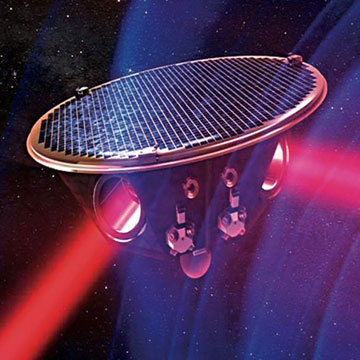 Lonodon:
Lonodon: Earlier this year, scientists announced the detection of gravitational waves—Einstein’s ripples in spacetime—for the first time on Earth. Those ripples are now reverberating through NASA, nudging the agency to mend fences with the European Space Agency (ESA) and rejoin an ambitious mission, called the Laser Interferometry Space Antenna (LISA), to study gravitational waves from space.
This week, at the 11th LISA symposium in Zürich, Switzerland, a NASA official said he was ready to rejoin the LISA mission, which the agency left in 2011. Meanwhile, ESA says it is trying to move the launch of the mission up several years from 2034. “This is a very important meeting,” says David Shoemaker, a gravitational wave physicist at the Massachusetts Institute of Technology in Cambridge. “It feels like a turning point.”
Plans for LISA date back more than 2 decades. Three separate spacecraft, flying millions of kilometers apart from each other at the vertices of a giant triangle, would precisely measure their mutual separations using sensitive lasers, and thus be capable of detecting low-frequency ripples in spacetime. The objects causing these low-frequency ripples—such as orbiting supermassive black holes at the centers of distant galaxies—would be different from the higher frequency ripples, emitted by collisions of much smaller black holes, that have so far been detected on Earth.
Originally, LISA was conceived as a joint ESA-NASA mission. Both partners would pay 50% of the mission cost, estimated at some $2 billion. But in April 2011, NASA dropped out of the collaboration because of budgetary problems, and the program was almost killed. “The next year, the LISA symposium felt like a funeral,” recalls astrophysicist Paul McNamara of ESA’s space research and technology center ESTEC in Noordwijk, the Netherlands.
Then, in 2013, a trimmed-down, €1 billion version of LISA was selected by ESA as its L3 mission—the third large mission in its Cosmic Vision 2020 program. Called eLISA (where the “e” euphemistically stands for “evolved”), it would have less capability and sensitivity than the original design. Launch was foreseen for 2034. NASA expressed interest to become a minor partner, providing technological support.
But things have changed a lot in the past few years. ESA’s technology demonstrator LISA Pathfinder, launched in December 2015, has performed flawlessly, says McNamara, who is the mission’s project scientist. Then, in February, the ground-based Laser Interferometer Gravitational-Wave Observatory experiment announced that it had bagged its first direct detections.
In June, a NASA-appointed L3 Study Team presented its interim report, suggesting ways for the agency to rejoin the program as a senior partner. And on 15 August, a midterm assessment of the National Academy of Sciences’s (NAS) 2010 Decadal Report, which reviews U.S. priorities for astronomy and astrophysics, strongly recommended NASA to restore support to the space observatory this decade, and to help restore the mission to its original full capacity.
It now looks like the recommendations are taking effect. At the Zürich meeting, Paul Hertz, the director of NASA’s astrophysics division, said: “2011 saw the dissolution of our original LISA partnership. But I’m here to move forward from that.” NASA’s contribution may not get back to 50%, but according to the NAS report, what’s required is “a significantly larger U.S. contribution than the $150 million […] currently being considered”.
Meanwhile, ESA’s Director of Science Alvaro Giménez in Madrid announced that the call for mission concepts for eLISA will be brought forward from 2018 to next month. “We want to make your dreams come true,” he told the gravitational-wave scientists at the meeting. “Although 2029 is probably too optimistic, we might be able to launch the mission a few years earlier, somewhere in the early 2030s.” According to Giménez, not restoring a much stronger partnership with NASA is now almost unthinkable.
Scientists at the meeting were pleased. “When we launch 14 or 15 years from now, this meeting will be seen as the rebirth of LISA,” says Karsten Danzmann of the Albert Einstein Institute in Hannover, Germany, who is LISA Pathfinder’s co–principal investigator. #Source: The Science
 Lonodon: Earlier this year, scientists announced the detection of gravitational waves—Einstein’s ripples in spacetime—for the first time on Earth. Those ripples are now reverberating through NASA, nudging the agency to mend fences with the European Space Agency (ESA) and rejoin an ambitious mission, called the Laser Interferometry Space Antenna (LISA), to study gravitational waves from space.
Lonodon: Earlier this year, scientists announced the detection of gravitational waves—Einstein’s ripples in spacetime—for the first time on Earth. Those ripples are now reverberating through NASA, nudging the agency to mend fences with the European Space Agency (ESA) and rejoin an ambitious mission, called the Laser Interferometry Space Antenna (LISA), to study gravitational waves from space.